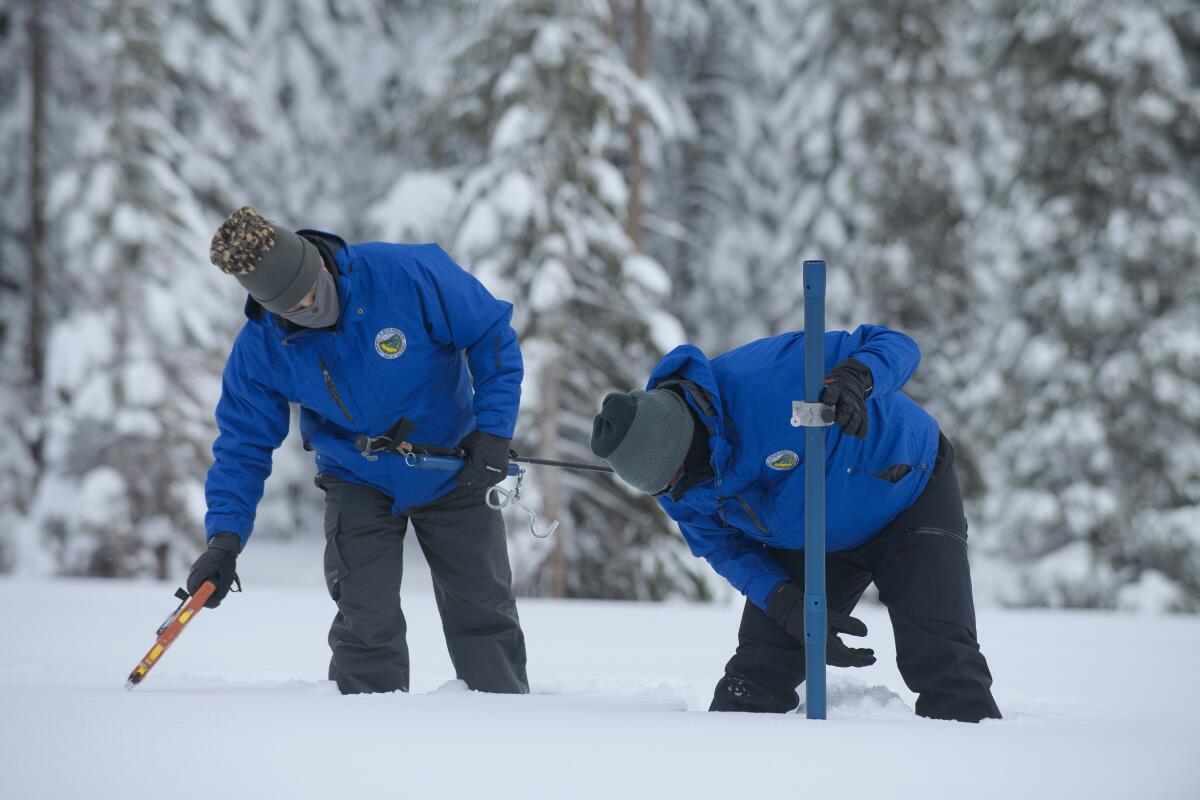California ends year with heavy snow, but officials say the drought is far from over

- Share via
After two of California’s driest years on record, a spectacularly stormy December blanketed the Sierra Nevada with heavy snow, giving a major boost to the state’s water supplies.
California’s mountain snowpack now stands at 160% of average for this time of year, state officials said Thursday as they conducted their first snow survey of the season.
“We are off to a great start,” said Sean de Guzman, manager of snow surveys for the Department of Water Resources. “We still have a long way to go for our wet season, and we need more and more of these storms to keep coming through.”
With the state’s depleted reservoirs still below average levels, he said, California is “definitely not out of the woods.”
“This drought is still far from over,” de Guzman said.
State officials measured the water content of the snowpack at Phillips Station snow course, as they do five times during the winter and spring each year. The measurements of snowpack at a network of about 260 sites across the Sierra Nevada are used to forecast how much snowmelt runoff will fill the state’s reservoirs in the coming months.
The storms that rolled in this month brought record snowfall in parts of the Sierra Nevada. More than 17 feet of snow — 212 inches in all — accumulated at Donner Pass in December, according to the UC Berkeley Central Sierra Snow Lab.
California gets much of its rain and mountain snow between November and March.
“A wet start doesn’t always mean that this year will be wet once it’s all said and done,” de Guzman said.
In 2013, for example, the winter began with ample snow, “eerily similar to where we are today,” de Guzman said, but then the “spigot shut off” in January and was followed by an extraordinarily dry year.
Though California naturally goes through dramatic swings between dry spells and deluges, higher temperatures brought on by climate change are making droughts more intense.
In 2021, the Sierra Nevada snowpack peaked at 72% of average in April but then rapidly melted during the hottest spring on record.
Extreme heat last winter baked much of the West and left parched soils, which soaked up a portion of the runoff and left diminished flows in rivers, adding to California’s drought woes.
“Last year’s snowmelt runoff basically never arrived,” de Guzman said.
“And that’s really concerning considering California’s snowpack provides about a third of our water each year,” he said. “It really tells us that climate change is here and that it’s really impacting our watersheds, as well as our snowpack.”
Over the past two years, as the dry months persisted, water levels fell dramatically in reservoirs throughout the state. And while reservoirs have risen some after recent rains, they remain low. The level of Lake Shasta, the state’s largest reservoir, still sits at 50% of average for this time of year, while the second-largest, Lake Oroville, is at 73% of average.
The snow that falls in the Sierra Nevada over the next three months will determine how much more the reservoirs will rise before the dry season returns.
The state’s water management officials use April 1 as an annual finish line for measuring the Sierra snowpack, around the time when the snow typically peaks.
Even after this snowy December, state water officials said the amount of snow to date represents only about 55% of the April 1 seasonal average.
“The amount of snow we got here in December got us about half of that bucket filled, so halfway to where we would like to be on April 1 just for average conditions,” said David Rizzardo, manager of the Department of Water Resources’ hydrology section. “We really need January to produce and February to produce and March to produce. And some of the climate outlooks suggests that they’ll be dry.”
He and other water officials said despite all the snow and rain in December, Californians need to be aware that even this bounty in the mountains may not be enough to refill the state’s major reservoirs.
“We need more storms and average temperatures this winter and spring, and we can’t be sure it’s coming,” DWR Director Karla Nemeth said in a statement. “It’s important that we continue to do our part to keep conserving — we will need that water this summer.”
Adel Hagekhalil, general manager of the Metropolitan Water District of Southern California, said the snowfall across California is a welcome sight.
“But regardless of the precipitation we see in the near term, we need to continue our efforts to build sustainable water supplies that make us more resilient to drought and the changing climate,” Hagekhalil said. He said that will require investing in conservation, wastewater recycling and water storage projects “to take advantage of big water years when they come.”
At Phillips Station, where de Guzman spoke to reporters, the surveyors measured 78.5 inches of snow, 202% of average for this location on this date.
The site lies in the American River watershed in the central Sierra. The latest measurements show the snowpack varies, with sites in the northern Sierra recording 145% of average and the southern Sierra reaching 173% of average.
Standing on the snow, de Guzman stressed that the next few months will be critical.
“We don’t have a full bucket yet,” he said. “We’re hoping for that April 1 percent of average to get a lot higher so that we have more runoff to fill up a lot of those empty reservoirs.”
More to Read
Your guide to our clean energy future
Get our Boiling Point newsletter for the latest on the power sector, water wars and more — and what they mean for California.
You may occasionally receive promotional content from the Los Angeles Times.














